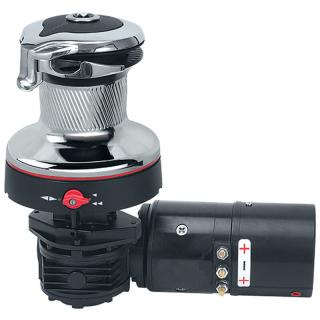Absolute Power Corrupts Absolutely: A powered winch risks havoc
Lessons from a British Virgin Islands Charter
“Safety Moments, presented at CCA Stations and Posts”
By Chuck Hawley, San Francisco Station, February 2020
This Safety Moment looks at some of the gear on a charter catamaran that, in the wrong hands or if used incorrectly, could do substantial damage. Charter boats, by their nature, can be mysterious craft for the week that you’re aboard, as you discover vital aspects of the boat that might have taken the first year of ownership had the boat been your own.
In my most recent case, our Moorings 4800 cat was equipped with two large Lewmar electric winches that provided sail handling power for every line except the mainsheet, which had its own unpowered winch. These powerful electric winches were operated by a tiny floor-mounted pushbutton that ostensibly was toe-operated, and which had a cover to prevent accidental operation. The potential risks with an electric winch are many, especially in the hands of an unfamiliar sailor.
To protect the innocent, and to make this a positive rather than a negative message, allow me to tell you what I learned from spending a week sailing with these winches. There’s no question that life aboard is easier with powered winches on a very heavy catamaran, especially when raising the fully-battened, bullet-proof mainsail, which used to take three of us about ten minutes of swearing and sweating.
- The winches are capable of developing so much line tension that you can damage the boat. We, luckily, did not damage our boat (by the grace of God), but since you lack the feedback that grinding on a winch handle affords, it’s possible to pull the clew right off of a genoa if you’re not sufficiently aware of the tension that is being created.
- To work efficiently, you must “fill the drum” of the winch with wraps. Each wrap of the sheet or halyard has progressively less tension on it, due to the friction that it produces, so that if there are 5-6 wraps, the self-tailing mechanism doesn’t have a dangerous amount of tension on it. If the tail of the sheet cannot be held with a couple of fingers, you haven’t placed enough wraps on the winch.
- Be wary of using the bank of sheet stoppers or line clutches at your disposal. It’s easy to forget that the jib sheet is jammed because you had some other line that just had to be adjusted, and then you find that you can’t crash tack if you need to because you don’t have the ability to cast off the sheet. When you’re under sail, you need to be able to cast off sheets instantly.
- Before releasing a jammer, put a few turns on the winch to ensure you’re not standing on the tail of a halyard that’s about to exit the cockpit at 100 knots. Every line should be cast off with care and under your control to avoid injury.
- Finally, don’t use an electric winch to do something that you wouldn’t be able to do with muscle power. Imagine you’re headed for Great Harbor on Jost Van Dyke, and you have delayed a little too long to strike the sails. The harbor is full of gorgeous, expensive yachts whose owners are flying the CCA burgee. Your crew takes the furling line and puts it on the drum of the big sheet winch and begins to pull against the strength of the wind in the sail. No one is easing it fast enough, and the furling line is bar tight and making popping sounds as it winds up on the winch drum. Pop! Pop! Pop! The sail is snapping so much that you can’t be heard by a crewmember who goes forward, on the leeward side, to see if he can “help” with the flogging sheets. With the main still drawing, you’re headed at a harbor at 8 knots and you cannot easily slow down. What could happen?
- Your helpful crewmember could get knocked overboard by the flogging sheets.
- Your furling line could part and the jib unroll entirely.
- You could damage the furler by putting too much force on the drum and bearings.
- You could round the boat into the wind and go into irons in front of everyone in the harbor. Then, in an effort to get out of irons, you start the engines and put them into gear without looking for lines over the side.
- You could gybe and put the jib aback and, assuming the mast remained in the boat, you could slowly regain control and try the approach again, tail between your legs, and CCA burgee stowed below where it will remain.
The point is that electric winches can make us over-confident in our sailing abilities, even as they open new opportunities to sail boats with smaller, and possibly older, crews. Like any tool on board, they require operational knowledge and a healthy amount of respect. Taking 30 minutes to go over their operation, at the expense of teaching the “Old Salts” something that they will claim to know already, is extremely worthwhile. Even Old Salts can benefit from a little continuing education once and awhile.
The Cruising Club of America is a collection of passionate, seriously accomplished, ocean sailors making adventurous use of the seas. All members have extensive offshore boat handling, seamanship, and command experience honed over many years. “School of Hard Rocks” stories, published by the CCA Safety and Seamanship Committee, are intended to advance seamanship and help skippers promote a Culture of Safety aboard their vessels





